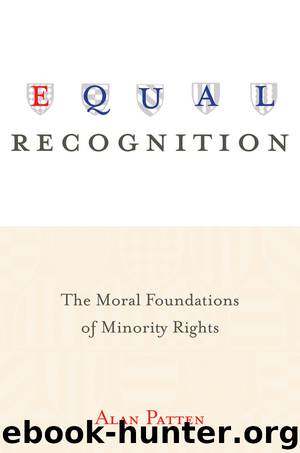Equal Recognition by Patten Alan;

Author:Patten, Alan;
Language: eng
Format: epub
Publisher: Princeton University Press
Published: 2014-02-25T16:00:00+00:00
Other examples of recognition could be given as well, although the illustrations above should suffice for the purposes of this chapter’s general theoretical argument. Decisions about the school curriculum (which literature and whose history should be taught?) will sometimes involve recognition in the sense I have stipulated, as will decisions about official flags, anthems, uniforms, and other symbols. Any time the state establishes a particular religion, it can be said to recognize that religion in my sense of the term.
Clearly, a state might adopt several different approaches to recognition. It might seek to avoid conferring recognition on any religion or culture (or identity-related conception of the good). A state might, for instance, refuse to designate any particular holidays or days of rest and instead support a system in which employees are free to choose their own days off. There would be serious difficulties with such a scheme, stemming from the fact that individuals and employers like to coordinate their days off with others, but at least the scheme would not recognize any religion or culture. Alternatively, a state might designate one out of several religions or cultures—typically, the majority one—and recognize it exclusively. It might, for instance, make Sunday the weekly day of rest on the grounds that having some designated day rather than no designated day avoids various problems of coordination, and that having this day designated accommodates the preferences of the majority. Or, third, a state might designate several different cultures or religions and try to assist each of them in some relevantly equivalent way. It might, for instance, designate Sundays as the default weekly day of rest but allow individuals to opt out of the default scheme and designate some different day that accords with their religious or cultural commitments.8
Among the various strategies a state might adopt, then, are nonrecognition, majoritarian recognition, and equal recognition. Equal recognition is of special salience to my project, so let me say something more about it. The account of even-handed entanglement in the previous chapter provides the basic model. Two or more cultures (or religions, etc.) are equally recognized when a comparable form of customized assistance is extended to each of them. The same kinds of rules, facilities, and resources that are offered to assist one are also offered to assist the other(s).
As I have suggested, a scheme that allows employees to take time off work on particular designated days associated with minority religions would represent a more equal form of recognition, in the proposed account, than would a scheme that gave time off only on days associated with the majority religion. A state that offers public services in one or more minority languages, as well as in the majority language, would come closer to equal recognition than a state that insisted on offering all its services exclusively in the majority language (or that offered minority-language services only on a temporary and transitional basis to people who are in the process of learning the majority language). And a state that establishes
Download
This site does not store any files on its server. We only index and link to content provided by other sites. Please contact the content providers to delete copyright contents if any and email us, we'll remove relevant links or contents immediately.
| Anthropology | Archaeology |
| Philosophy | Politics & Government |
| Social Sciences | Sociology |
| Women's Studies |
The remains of the day by Kazuo Ishiguro(8395)
Tools of Titans by Timothy Ferriss(7815)
Giovanni's Room by James Baldwin(6810)
The Black Swan by Nassim Nicholas Taleb(6770)
Inner Engineering: A Yogi's Guide to Joy by Sadhguru(6442)
The Way of Zen by Alan W. Watts(6289)
Asking the Right Questions: A Guide to Critical Thinking by M. Neil Browne & Stuart M. Keeley(5357)
The Power of Now: A Guide to Spiritual Enlightenment by Eckhart Tolle(5333)
The Six Wives Of Henry VIII (WOMEN IN HISTORY) by Fraser Antonia(5238)
Astrophysics for People in a Hurry by Neil DeGrasse Tyson(5002)
12 Rules for Life by Jordan B. Peterson(4161)
Housekeeping by Marilynne Robinson(4065)
The Ethical Slut by Janet W. Hardy(4040)
Skin in the Game by Nassim Nicholas Taleb(3968)
Double Down (Diary of a Wimpy Kid Book 11) by Jeff Kinney(3927)
Ikigai by Héctor García & Francesc Miralles(3895)
The Art of Happiness by The Dalai Lama(3847)
Skin in the Game: Hidden Asymmetries in Daily Life by Nassim Nicholas Taleb(3724)
Walking by Henry David Thoreau(3681)
